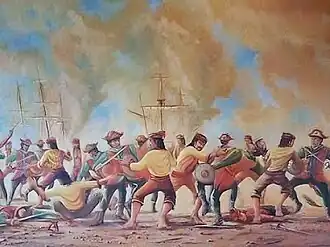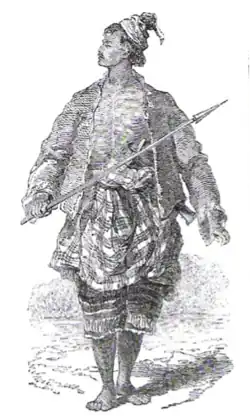Twenty Years' War
| Twenty Years' War | ||||||||||
|---|---|---|---|---|---|---|---|---|---|---|
| ||||||||||
| Belligerents | ||||||||||
|
| |||||||||
| Commanders and leaders | ||||||||||
|
|
|
| ||||||||
| Units involved | ||||||||||
|
|
|
| ||||||||
| Strength | ||||||||||
|
|
| ||||||||
| Casualties and losses | ||||||||||
|
|
|
| ||||||||
the Twenty Years' War or the Bruneian–Sulu War was a conflict between the Sulu Sultanate and the Bruneian Empire. Brunei also fought Spain briefly as well.
This war was also the first time Brunei ever used flintlock muskets, as they began acquiring them in the late 17th century and early 18th century[2][4]
Background
The Sultan of Sulu was instated by the British to control Manila in 1763.[5] Sultan Omar Ali Saifuddin who learned about the situation in Manila, he was displeased as Azim ud-Din I was a apostate.[6] As a result, he commanded an attack on the Sulu Sultanate in Manila with his forces under the command of Pehin Orang Kaya Di-Gadong Seri Lela Awang Aliwaddin.[7]
War
| This article is part of a series on the |
| History of Brunei |
|---|
 |

The mission did not arrive in Manila until 1769 because the expedition's preparations took so long. Sultan Azim ud-Din I (Alimuddin) had already departed Manila for Sulu in 1764 after the Treaty of Paris, therefore Manila was under Spanish rule when the siege began.[8] The siege was successful besieged for Brunei, capturing it in the process.[9]
The Sulu Sultanate then despatched a force under the command of Datu Teting to attack Balambangan in 1775, the leaders of Balambangan sought safety in Labuan after the British quickly established a presence in Brunei.[10] When the two forces clashed, Datu Teting surrendered and his troops fled back to Sulu after learning that the warriors of Brunei, led by Pengiran Temenggong Ampa, were far too strong for them to defeat.[11][3]
In 1788, A Sulu army attacked many coastal villages around Sabah as an attempt to invade Brunei, lead by Datu Teting who previously burned Balambangan before retreating, arriving to Kampung Sembulan in said year. They were later defeated by again Pengiran Temenggong Ampa, Sharif Amir and Raja Tua of Mengkabong. Sharif Ali later became the caretaker of Kampung Sembulan one of many coastal villages in Sabah.[3]
Aftermath
_by_Francis_Grant.jpg)
Thanks to their numerical and military advantage over Sulu, Brunei effectively defeated the Sulu Sultanate. Though piracy raids continued after the war, Brunei reclaimed all of their lost territory in the war against Sulu. Brunei stopped any more Sulu invasions against Brunei. The war was pivotal for restoring Brunei's dominance in Borneo and stopped anymore foreign incursions into Brunei until the mid–19th century when James Brooke arrived.
Who would later be responsible of one of many factors that caused the decline of the Bruneian Sultanate, making it decline heavily into 1870 to 1888.[12][13] Which eventually forced Sultan Anak Hashim to sign the Protectorate Agreement in 1888.
Notes
References
- ^ Blair & Robertson.
- ^ a b Saunders, Graham (2003). A History of Brunei (2nd ed.). London: Routledge. ISBN 9781315029573.
- ^ a b c d Santos, Jason (5 December 2020). "History of Sembulan: home to remnants of ancient Brunei army Part 1". The Vibe.
- ^ Keppel, Captain (1846). "THE EXPEDITION TO BORNEO OF H.M.S. DIDO FOR THE SUPPRESSION OF PIRACY: WITH EXTRACTS FROM THE JOURNAL OF JAMES BROOKE, ESQ., OF SARAWAK". The Daily Brunei Resources. Retrieved 1 September 2009.
- ^ Tracy, Nicholas (1995). Manila Ransomed. University of Exeter Press. pp. 73–74, 106. ISBN 0859894266.
- ^ Larousse & Pontificia Università gregoriana. Centre "Cultures and Religions." 2001, p. 77
- ^ Masa silam sarana masa depan: kumpulan kertas kerja Seminar Sejarah Brunei II (in Malay). Jabatan Pusat Sejarah, Kementerian Kebudayaan, Belia dan Sukan. 1999. p. 18. ISBN 978-99917-34-16-3.
- ^ al-Sufri (Haji), Awang Mohd Jamil (2002). Survival of Brunei: A Historical Perspective. Brunei History Centre, Ministry of Culture, Youth and Sports. p. 36. ISBN 978-99917-34-18-7.
- ^ 50 Years Historical Moments of Omar Ali Saifuddien Mosque, 1958-2008 (in Malay). Ministry of Religious Affairs, Negara Brunei Darussalam. 2008. p. 68. ISBN 978-99917-922-0-0.
- ^ Vienne, Marie-Sybille de (2015-03-09). Brunei: From the Age of Commerce to the 21st Century. NUS Press. p. 74. ISBN 978-9971-69-818-8.
- ^ History, Borneo (2014-12-29). "Borneo History: Sultan Omar Ali Saifuddien I". Borneo History. Retrieved 2023-04-07.
- ^ Saunders, Graham (2013-11-05). A History of Brunei (0 ed.). Routledge. p. 74. doi:10.4324/9781315029573. ISBN 978-1-136-87394-2.
- ^ Bachamiya Abdul Hussainmiya (2006). Brunei: revival of 1906 ; a popular history. Bandar Seri Begawan: Brunei Press. p. 32. ISBN 978-99917-32-15-2.